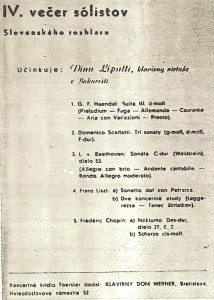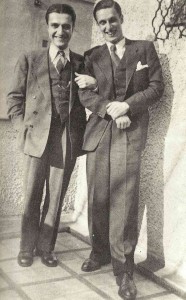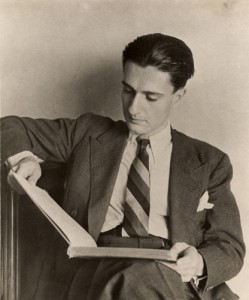The following is a list of the works that Dinu Lipatti is known to have played in public. It is based on existing concert programs and letters that give evidence that Lipatti actually played these works in concert – his private repertoire was larger. Occasionally, the list – originally compiled by  Lipatti biographer Grigore Bargauanu and the collector Marc Gertsch, with a few additions made now – lacks some detail in terms of exact works: for example, Lipatti played at least six Chopin Preludes, but exactly which ones he performed are unknown. Many of the works – particularly the four Beethoven Sonatas and the Schubert B-Flat Sonata! – are from his early performing years in the 1930s; he played the Waldstein throughout his career, however, and not only in the last few years of his life as his recording engineer Walter Legge erroneously reported. Some of the works that he did play in his later years include Bach Prelude and Fugues, Schumann’s Études Symphoniques, Ravel’s Le tombeau de Couperin, and Chopin’s Fourth Ballade.
Lipatti biographer Grigore Bargauanu and the collector Marc Gertsch, with a few additions made now – lacks some detail in terms of exact works: for example, Lipatti played at least six Chopin Preludes, but exactly which ones he performed are unknown. Many of the works – particularly the four Beethoven Sonatas and the Schubert B-Flat Sonata! – are from his early performing years in the 1930s; he played the Waldstein throughout his career, however, and not only in the last few years of his life as his recording engineer Walter Legge erroneously reported. Some of the works that he did play in his later years include Bach Prelude and Fugues, Schumann’s Études Symphoniques, Ravel’s Le tombeau de Couperin, and Chopin’s Fourth Ballade.
It is an enticing list that makes the lack of more recordings by this unique artist all the more regrettable. Let us hope that some other concert broadcasts or private recordings will be found!
Works for Solo Piano and Two Pianos
Albéniz
Iberia, Book 1 – 1. Evocación
Iberia, Book 1 – 2. El Puerto
Iberia, Book 2 – 3. Triana
Navarra (transcribed by Lipatti)
Petite serenade
Andricu
Two Dances
Two Pieces Op.18
Bach
Chorale in G Major, BWV 147 “Jesu, Joy of Man’s Desiring” (arr. Hess)
Chorale Prelude, “Ich ruf zu Dir, Herr Jesu Christ” BWV 639 (arr. Busoni)
Chorale Prelude, “Nun komm, der Heiden Heiland” BWV 659 (arr. Busoni)
English Suite No.3 in G Minor, BWV 808
Italian Concerto, BWV 971
Partita No.1 in B-Flat Major, BWV 825
Pastorale in F Major for organ, BWV 590 (transcribed Lipatti)
Phantasy in A Minor, BWV 904
Preludes and Fugues from the Well-Tempered Clavier (at least 4)
Prelude and Fugue in E Minor for organ, BWV 533
Siciliano from Flute Sonata, BWV 1031 (arr. Kempff)
Toccata in D Major, BWV 912
Toccata in C Major, BWV 564 (arr. Busoni)
Bartók
Allegro barbaro
Six Dances in Bulgarian Rhythm (Mikrokosmos Vol.6)
Sonata for Piano
Beethoven
Piano Sonata No.7 in D Major, Op.10 No.3
Piano Sonata No.17 in D Minor, Op.31 No.2
Piano Sonata No.21 in C Major, Op.53 “Waldstein”
Piano Sonata No.23 in F Minor, Op.57 “Appassionata”
Berkeley
Concert Polka for Two Pianos
Brahms
Capriccio in D minor, Op.116 No.7
Intermezzo in A Minor, Op.116 No.2
Intermezzo in E-Flat Major, Op.117 No.1
Intermezzo in B-Flat Minor, Op.117 No.2
Intermezzo in E-Flat Minor, Op.118 No.6
Intermezzo in C Major, Op.119 No.3
Variations on a Theme by Haydn for Two Pianos
Waltzes Op.39 for Two Pianos (Nos. 1, 2, 5, 6, 10, 14, 15 – and perhaps others)
Brero
Five Preludes
Bull
Variations for Keyboard
Byrd
Various Pieces for Keyboard
Casella
Sonatina
Chopin
Ballade No.4 in F Minor, Op.52
Barcarolle in F-Sharp Major, Op.60
Étude in A Minor, Op.10 No.2
Étude in G-Flat Major, Op.10 No.5
Étude in C Major, Op.10 No.7
Étude in F Major, Op.10 No.8
Étude in E Minor, Op.25 No.5
Étude in A Minor, Op.25 No.11
Mazurka in E Minor, Op.41 No.1
Mazurka in B Major, Op.41 No.2
Mazurka in C-Sharp Minor, Op.41 No.4
Mazurka in C-Sharp Minor, Op.50 No.3
Nocturne No.8 in D-Flat Major, Op.27 No.2
Polonaise in E-Flat Major, Op.22
Polonaise in F-Sharp Minor, Op.44
Polonaise-Fantaisie in A-Flat Major, Op.61
various Preludes Op.28 (at least 6)
Rondo in F Major, Op.5
Scherzo No.1 in B Minor, Op.20
Scherzo No.3 in C-Sharp Minor, Op.39
Scherzo No.4 in E Major, Op.54
Sonata No.3 in B Minor, Op.58
Waltzes Nos.1 through 14
Waltz Op. Posth (which one is unknown)
Debussy
Arabesque (No.1 or 2)
Estampes No.2, “La soiree dans Grenade”
Étude pour les arpèges composés (and possibly others)
L’isle joyeuse
Images Book 1 No.1: “Reflets dans l’eau”
Images Book 1 No.2: “Hommage a Rameau”
Preludes (various)
Dohnányi
Capriccio in F Minor, Op.28 No.6
Enescu
Piano Sonata No.1 in F-Sharp Minor, Op.24 No.1
Piano Sonata No.3 in D Major, Op.24 No.3
Suite No.2 in D Major, Op.10
Variations on an Original Theme for two pianos, Op.5
De Falla
Ritual Fire Dance
Fauré
Impromptu No.3 in A-Flat Major, Op.34
Nocturne No.1 in E-Flat Minor, Op.33
Françaix
Concertino for two pianos
Handel
Suite No.3 in D Minor, HWV 428
Jora
Jewish March Op.8
Klepper
Two Dances
Lazar
Two Bagatelles
Lipatti
Compositions of childhood
Romanian Dances for two pianos
Three Dances for two pianos
Nocturne
Phantasie for piano solo
Sonatina for left hand
Suite for two pianos
Liszt
Concert Etude, “La Leggierezza”, S.144
Concert Etude, “Gnomenreigen”, S.145
Harmonies du soir
Mephisto Waltz No.1
Sonetto del Petrarca No.104
Mihalovici
Deux pieces impromptues, Op.19
Mozart
Piano Sonata No. 8 in A Minor, K.310
Sonata for Two Pianos in D Major, K.448
Mozart-Busoni
Duettino concertante for two pianos
Negrea
Sonatine Op.8
Nottara
Two Dances
Poulenc
Six Nocturnes
Ravel
Miroirs No.4, “Alborada del gracioso”
Miroirs No.5, “La vallee des cloches”
Le tombeau de Couperin
La Valse for two pianos
Scarlatti
Piano Sonata in E Major, L.23
Piano Sonata in G Major, L.387
Piano Sonata in D Minor, L.413
Piano Sonata in B-Flat Major
Piano Sonata in F Major
Piano Sonata in G Minor
Schubert
Impromptu No.2 in E-Flat Major, D.899 No.2
Impromptu No.3 in G-Flat Major, D.899 No.3
Piano Sonata No.21 in B-Flat Major, D.960
Allegro in A Minor for two pianos, D.947
Schumann
Blumenstück, Op.19
Carnaval, Op.9
Études Symphoniques, Op.13
Novelette No.2 in D Major, Op.21
Stravinsky
Danse russe (from “Petrouchka”)
Sonata for piano
Weber-Corder
Invitation to the Dance for two pianos








